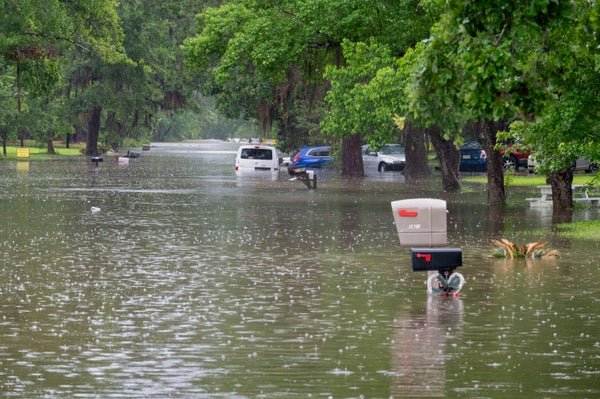West Nile Virus Proliferates where Climate Change Brings Warm, Wet Weather

August 21, 2024
3 min read
West Nile Virus Proliferates where Climate Change Brings Warm, Wet Weather
Houston’s warm, wet spring, driven in part by climate change, was a boon for mosquitoes and West Nile virus

Cars are submerged and the tops of mailboxes are visible along a residential street in Woodloch, 30 miles north of Houston as floodwaters rise Friday, May 3, 2024.
Kirk Sides/Houston Chronicle via Getty Images
CLIMATEWIRE | Houston is seeing a spike in West Nile virus cases — and climate change is to blame.
As of mid-August, 24 people in Texas’ Harris County had contracted the virus, and more than 600 mosquito samples tested positive for it. By contrast, over the past five years, the area saw fewer than 10 cases annually, and positive mosquito samples never rose above 320.
It’s just the latest case of climate-fueled weather increasing the transmission of vector-borne infectious diseases.
On supporting science journalism
If you’re enjoying this article, consider supporting our award-winning journalism by subscribing. By purchasing a subscription you are helping to ensure the future of impactful stories about the discoveries and ideas shaping our world today.
“Viruses like heat,” said Maximea Vigilant, director of mosquito and vector control at Harris County Public Health.
Climate change contributed to Houston’s spike in a few ways, Vigilant said.
First, the city experienced above-average rain in the spring, fueling the wet, warm conditions that boosted local mosquito populations. Then unusually high temperatures in the spring and summer helped the virus multiply and spread among migratory birds, which then infected the mosquitoes that bit them.
“We have a situation where the virus amplified within the host, the birds, and when the mosquitoes took their blood meal, they became infected,” he said.
West Nile virus is the leading cause of mosquito-borne disease in the United States. According to the Centers for Disease Control and Prevention, most people infected with the virus do not feel sick, but 1 in 5 develop a fever and other symptoms. Roughly 1 in 150 infected people develop serious or fatal illnesses, and infection can lead to lifelong autoimmune diseases.
It can be hard to track climate change’s influence on West Nile virus cases at a national level. That’s partly because multiple weather conditions influenced by climate change can, in turn, affect mosquito and bird populations, as well as virus transmission.
EPA notes that cases nationwide have varied widely, with the highest incidence occurring in 2012.
While wet, warm weather generally increases mosquito breeding, drought has also been associated with increased virus outbreaks. Human exposure to mosquitoes and the diseases they carry can also vary depending on local geography.
But West Nile virus has become an increasing cause of concern in some localities, said Sarah Hunt, president of the Rainey Center for Public Policy, which helps connect local government officials with experts through its Leadership Alliance for a More Perfect Union program.
“People may disagree about the extent climate change is contributing, but across the political spectrum they are seeing these effects of diseases and vectors that come from increased temperatures and water being where it’s not supposed to be,” she said.
That was the case in Utah County, Utah, two years ago when snow pack hit a 175-year record high. Local officials knew that could spell trouble when the snow melted and water rushed into areas that were usually dry, activating mosquito eggs that had laid dormant for years.
“We knew we were going to have nine or 10 years of eggs hatch and we had to get ahead of it so we didn’t end up with a record amount of West Nile or Zika or anything else,” County Commissioner Amelia Powers Gardner said.
The county used roughly $250,000 in emergency flooding funding to buy two drones that could spray larvicide in difficult-to-access areas and prevent mosquitoes from hatching.
The issue was personal for Powers Gardner, who contracted West Nile virus as a college student and still suffers light sensitivity, low muscle mass and other symptoms of a related autoimmune disease.
“This was not just, oh, mosquitoes are annoying. This was a public health crisis we needed to avoid,” she said.
Reprinted from E&E News with permission from POLITICO, LLC. Copyright 2024. E&E News provides essential news for energy and environment professionals.




